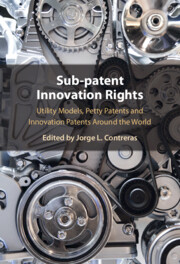Utility models, also known as petty patents, innovation patents and by various other names, are a long-established form of intellectual property right. Thus some national regimes date from as long ago as the late nineteenth or early twentieth century. They are also an increasingly widespread form of protection, now to be found in over a hundred countries. They are also an internationally recognized form of protection, notably by the Paris Convention for the Protection of Industrial Property since the Washington Act of 1911. As was first recognized in Uma Suthersanen’s pioneering study for UNCTAD in 2006, utility models are a form of protection which may be particularly suitable for developing economies. In developed economies, it is common for there to be cyclical debates as to the advantages and disadvantages of such rights, and in particular whether, as some supporters claim, they foster innovation by small and medium-sized enterprises. For example, Australia introduced petty patents in 1979, reformed and re-named them innovation patents in 2001, but abandoned the system in 2021. Finally, utility models can interact with other rights, as was recently highlighted by the decision of the Grand Chamber of the Court of Justice of the European Union in Case C–382/21 P European Union Intellectual Property Office v. KaiKai Company Jaeger Wichmann GbR [EU:C:2024:172] (holding that an application for a Community-registered design could claim priority from a design right or utility model filed in another Contracting State of the Paris Convention in the preceding six months, but not from a patent).
Despite the ubiquity and significance of utility models, they have until now attracted very little attention from scholars. Jorge Contreras is therefore to be congratulated in taking the initiative of editing this volume. He has assembled an international team of distinguished scholars who, between them, have gone a long way to remedy the previous neglect of this important topic. There are chapters by national experts which explore the present or past laws of fifteen countries. In addition, there are cross-jurisdictional contributions which provide an overview of such systems, prospects for harmonisation at least within the European Union, interaction with other aspects of the intellectual property system and their economic impact. As such, the book can be whole-heartedly recommended to anyone with an interest in this corner of intellectual property law.

